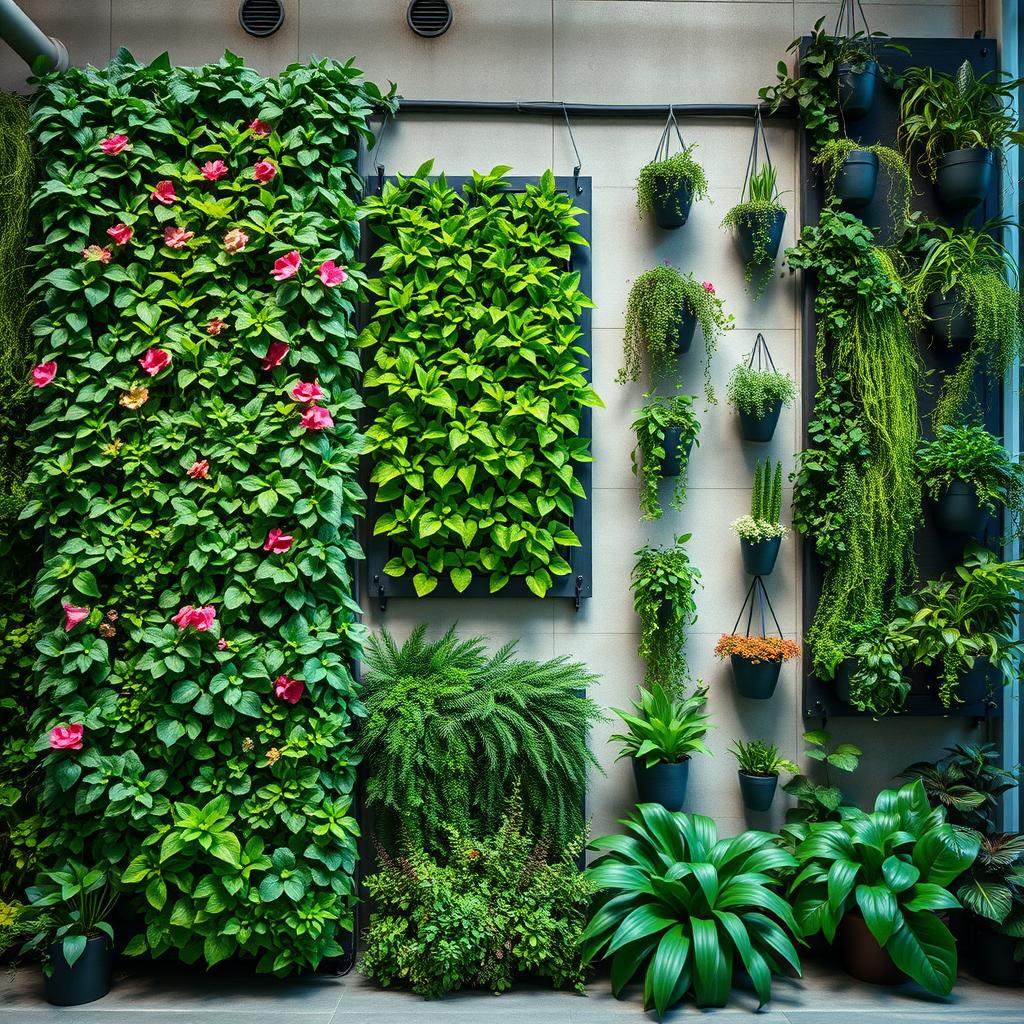Vertical gardening is a great way to use space, perfect for cities where regular gardens are hard to find. This guide covers the many types of vertical gardens. They can turn small areas like balconies and hallways into lush green spots.
These gardens are not just pretty; they also help the environment. They improve air quality and support local wildlife. This makes vertical gardening a hit with garden lovers and new homeowners.
Knowing about the different vertical gardens is key. It helps create a green haven that makes your space look better and feel healthier.
Key Takeaways
- Vertical gardening maximizes limited space effectively.
- Different types of vertical gardens cater to various aesthetics and needs.
- Benefits include improved air quality and increased biodiversity.
- Vertical garden design is accessible for both enthusiasts and beginners.
- Ideal for urban environments, maximizing small spaces and adding greenery.
Introduction to Vertical Gardening
Vertical gardening has become popular for using small spaces. It lets you grow plants up instead of out. This is great for both outdoor vertical gardens and indoor vertical gardens. It helps you make the most of your space without needing a lot of room.
This idea has been around for a long time. Ancient people used walls and trellises to grow plants. Now, with more people living in cities, vertical gardening is more appealing than ever. It’s perfect for adding greenery to balconies and patios.
You can grow many types of plants vertically, like flowers, herbs, and veggies. This makes it easy to make your space unique and support different plants. Whether you have a small apartment or a big backyard, vertical gardening offers endless possibilities.
Benefits of Vertical Gardens
Vertical gardens bring many benefits to both homeowners and city dwellers. They make any space look better by turning walls into green walls. This adds beauty and can even increase the value of a property.
Vertical gardens also create their own microclimates. They provide shaded areas that help control the temperature around buildings. This can save energy, as less heating or cooling is needed.
There are also mental health benefits to vertical gardens. Studies show that being around nature can lower stress. Adding greenery to cities makes them feel calmer and more welcoming.
Vertical gardens also improve air quality. Plants clean pollutants from the air and make oxygen. Gardening can make people feel happy and fulfilled, improving their life quality.
Using vertical gardens is a smart way to use space, even in cities where land is scarce. They allow for growing herbs, veggies, and flowers in creative ways. This supports sustainable living and shows off unique gardening ideas.
Types of Vertical Gardens
Exploring different types of vertical gardens can spark creative ideas for any space. These designs make the most of small areas and add life with greenery. Here are three popular types:
Living Walls
Living walls are complex systems where plants grow on walls. They use modular panels to create eye-catching displays. Brands like GSky and VertiPlant offer cutting-edge solutions for city spaces.
For living walls, choose a mix of succulents, ferns, and flowers. These plants thrive in tight spaces.
Pallet Gardens
Pallet gardens are a cost-effective and rustic option. They use wooden pallets to grow plants, adding texture and color. This design encourages creativity, perfect for growing herbs, strawberries, and flowers.
It’s easy to start a pallet garden, making it great for beginners.
Hanging Gardens
Hanging gardens are both beautiful and practical. They feature plants in hanging containers, turning any area into a green oasis. Using recycled materials adds a personal touch.
Plants like trailing vines, grasses, and annuals look great in hanging gardens. They enhance both indoor and outdoor spaces.
DIY Vertical Gardens
Creating a vertical garden is a rewarding project. It adds greenery and beauty to any space. Knowing the materials and steps makes it easy for anyone to succeed. This guide will cover what you need and how to start.
Materials Needed
First, gather the right materials for your vertical garden. Here’s a list of basics:
- Trellises or framework for support
- Planting containers that fit your chosen design
- Lightweight potting soil suitable for vertical gardening
- Plants that thrive in vertical environments, such as herbs, succulents, or compact flowering plants
- Watering can or a spray bottle for easy watering
Easy Steps to Create Your Own
Starting a vertical garden is easy. Just follow these steps to beautify any wall or outdoor area:
- Plan Your Design: Think about the space and sunlight. This helps pick the right plants.
- Assemble the Materials: Build a strong framework for your plants and soil.
- Prepare the Containers: Fill containers with potting soil, leaving room for roots.
- Select Your Plants: Pick plants based on light. Some need sun, others shade.
- Planting: Place your plants in the containers. Make sure they have enough room.
- Watering Techniques: Water gently. Use a spray bottle for delicate plants.
By following these steps, you can create a beautiful vertical garden. It will add life and joy to any area.
Indoor Vertical Gardens
Indoor vertical gardens bring nature into our homes, making them look better and breathe easier. They face unique challenges like light and humidity issues. Choosing the right plants is key for success.
Pothos, ferns, and succulents are great for indoor gardens. They do well in low light and need less water than outdoor plants.
Indoor gardening comes with its own set of problems, like pests and dry air. Regular checks and natural pest control can help. Using a humidifier or grouping plants can also keep moisture levels up.
Indoor gardens are more than just plants; they create peaceful spaces. With a little creativity, you can make a living wall or use shelves to display your plants. They add beauty and life to any room, big or small.

